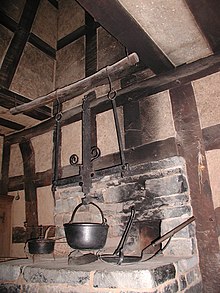Hearth爐灶
- A hearth is the paved floor of a fireplace, or the brick, stone, or concrete area in front of it. Hearths are associated with home and family because they were historically the main source of heat and cooking in the home.
Far from the Hearth: Essays in Honour of Martin K. Jones
Description
The essays in this volume honour a man whose research over the last four decades has exemplified the potential of archaeology, archaeological science and their cognate disciplines to address central questions about food and human nature. The volume comprises 17 thematic papers, all focused on the archaeology of food and arranged into three sections reflecting Martin Jones’ wide-ranging career. The first section, A Botanical Battleground, honours his central role in the development of archaeobotany and biomolecular archaeology. The second, The Stomach and the Soul, discusses the archaeology of food from evolutionary perspectives; while the final section, Between Fertile Crescents, connects to his recent research on food globalization in prehistory. The assembled chapters emphasize not only the food itself, but also the communities who produced and consumed it, as Martin Jones has repeatedly demonstrated that it is the interconnection between social and biological discourses that sheds most light on the human past. Far from the time when the first hearth was ever built, the research of archaeologists connects the meals of the present to past communities and their interconnections to each other and to plants.
本書中的文章向一位學者致敬,他在過去四十年的研究證明了考古學、考古科學及其相關學科在解決有關食物和人性的核心問題方面的潛力。本卷包含 17 篇主題論文,全部聚焦於食物考古學,分為三個部分,反映了馬丁瓊斯廣泛的職業生涯。
第一部分「植物戰場」紀念他在考古植物學和生物分子考古學發展中的核心角色。
第二部《胃與靈魂》從進化的角度討論了食物的考古學;
最後一部分「新月沃土之間」則與他最近對史前時期糧食全球化的研究有關。
這些章節不僅強調食物本身,也強調生產和消費食物的社區,正如馬丁瓊斯一再證明,社會和生物話語之間的相互聯繫最能揭示人類的過去。距離第一個壁爐建成的時間很遠,考古學家的研究將現在的食物與過去的社區以及它們之間的相互聯繫以及它們與植物之間的聯繫聯繫起來。
Title
Publisher
Publisher DOI
ISBN
 Hearth with cooking utensils
Hearth with cooking utensilsMartin K. Jones(英國劍橋大學考古學系George Pitt-Rivers講座教授);講題:”Contacts across Asia? The intriguing case of Neolithic millet farming”(跨越亞洲接觸嗎?新石器時代小米農業的有趣例子)時間:97年9月10日(三)上午10時啟;地點:中央研究院歷史語言研究所研究大樓 7樓會議室。Sci-Tech Encyclopedia:
Millet
A common name applied to at least five related members of the grass family grown for their edible seeds: foxtail millet (Setaria italica), proso millet (Panicum miliaceum), pearl or cat-tail millet (Pennisetum typhoideum), Japanese barnyard millet (Echinochloa frumentacea), raggee or finger millet (Eleusine coracana), and koda millet (Paspalum scrobiculatum).
As a crop for human food, pearl millet is grown widely in the tropics and subtropics in regions of limited rainfall where there is a growing season of 90 to 120 days. The naked seeds are yellowish to whitish in color and about the size of wheat grain. The dried grain is usually pulverized to make a meal or flour and then cooked in soups, in porridge, or as cakes.



沒有留言:
張貼留言